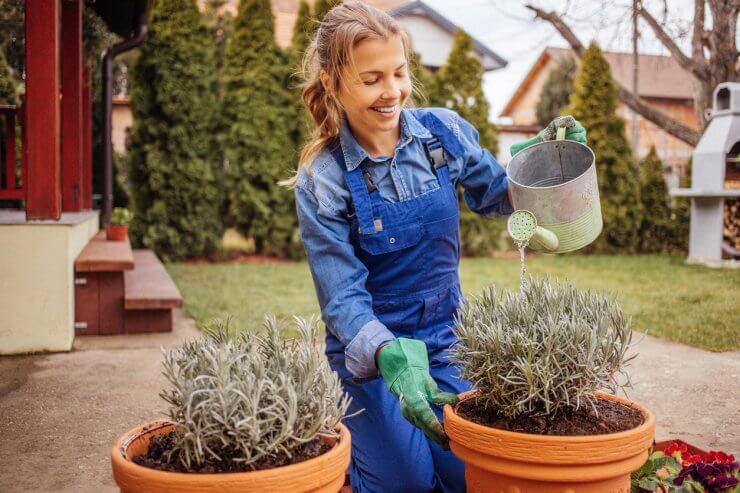
Gardener watering her container-grown lavender
Water
Once your lavender is settled in—whether it’s in a container, a raised bed, or open ground—give it some water once a week if it doesn’t rain. Remember, lavender is drought tolerant. It likes warm, dry conditions. No rain? No worries. Better to water a little than too much. Don’t kill your lavender plants with kindness. Soggy roots lead to root rot, which means no flowers for you.
In general, you’ll want to water lightly about once a week, so your plants get as much as an inch of water. If the top of the soil is a little dry, that’s OK. And this is a plant that doesn’t need mulch like many of your garden crops do. Mulch in the spring and summer will hold too much moisture in the soil, and lavender doesn’t like that.
It’s always best to water in the morning, so your plants can soak up the water and put it to work. Watering earlier in the day also gives the sun time to burn off any water on the leaves. When you do water, aim for the base of the plant. Try not to get the leaves wet (unless you’re blasting off pests); that can open the plant to fungal infection.
Weeding
If you’ve planted in raised beds or containers, weeds shouldn’t be much of a problem. If you do see weeds, pull them early and often—but be gentle about it. Loosen the soil gently around your plants, especially when they’re young, so you don’t disturb their roots. For raised beds and containers, this is another good reason to get yourself some fresh garden soil; it’s one less piece of aggravation to deal with during the growing season.
But even if you’re growing your lavender directly in the ground, properly preparing your soil is still an excellent preventive measure against the emergence of weeds. When you till or cultivate the area where you’ll plant your lavender, remove weeds and debris. You’ll likely find that the first few weeks after planting are the only time you’ll be pulling up weeds around your plants.
If weeds spring up around your lavender during the growing season, work the soil around the base of the plants with a hand rake—only deep enough to kill the weeds and not damage the plant’s roots.
The other thing you can do to reduce the likelihood of weeds is to lay down a layer of light colored sand or stones. The material will stop weeds, and the light color will reflect sunlight onto your plants, and we know that if there’s one thing lavender loves, it’s sunshine!
Fertilizer
Lavender is one of those unusual plants that doesn’t need fertilizer. Coming from the Mediterranean region, it’s adapted to be able to thrive despite poor soil conditions. So don’t waste any time worrying that you need to give your lavender plants a nutritional boost. They’ll be fine.
How often do you water your lavender? Do you have any particular challenges growing lavender? Please tell us your tips for nurturing healthy lavender plants.


 Previous
Previous

